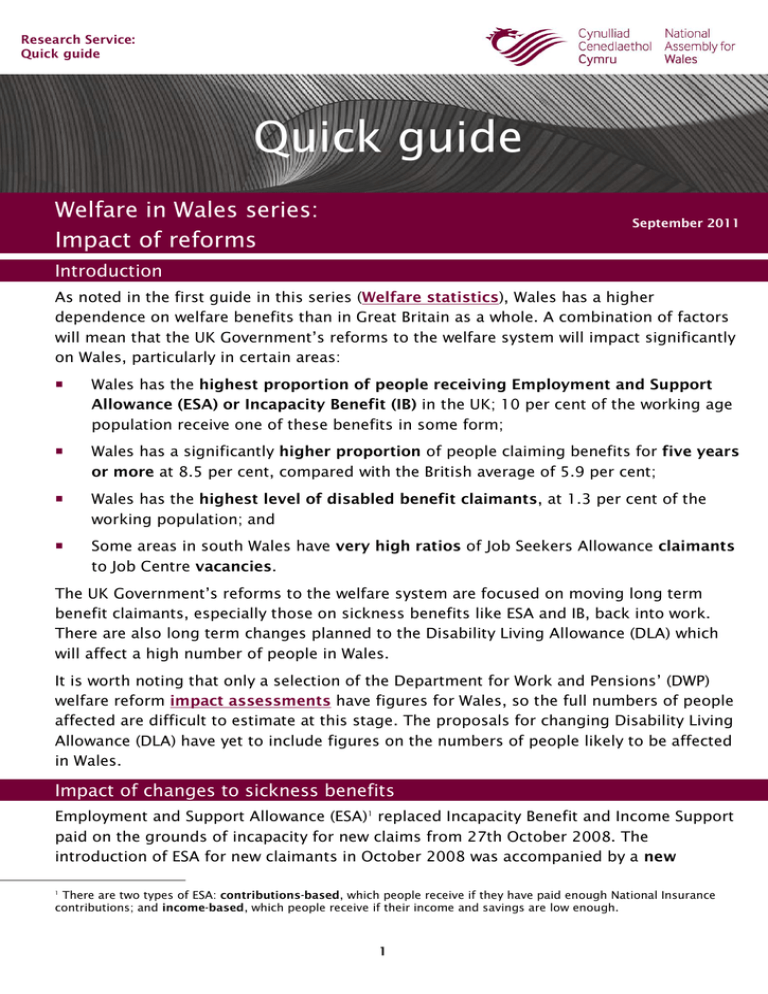Quick guide Welfare in Wales series: Impact of reforms What are Assembly Measures?
advertisement

Research Service: Quick guide Quick guide Welfare in Wales series: Impact of reforms September 2011 What are Assembly Measures? Introduction As noted in the first guide in this series (Welfare statistics), Wales has a higher dependence on welfare benefits than in Great Britain as a whole. A combination of factors will mean that the UK Government’s reforms to the welfare system will impact significantly on Wales, particularly in certain areas: Wales has the highest proportion of people receiving Employment and Support Allowance (ESA) or Incapacity Benefit (IB) in the UK; 10 per cent of the working age population receive one of these benefits in some form; Wales has a significantly higher proportion of people claiming benefits for five years or more at 8.5 per cent, compared with the British average of 5.9 per cent; Wales has the highest level of disabled benefit claimants, at 1.3 per cent of the working population; and Some areas in south Wales have very high ratios of Job Seekers Allowance claimants to Job Centre vacancies. The UK Government’s reforms to the welfare system are focused on moving long term benefit claimants, especially those on sickness benefits like ESA and IB, back into work. There are also long term changes planned to the Disability Living Allowance (DLA) which will affect a high number of people in Wales. It is worth noting that only a selection of the Department for Work and Pensions’ (DWP) welfare reform impact assessments have figures for Wales, so the full numbers of people affected are difficult to estimate at this stage. The proposals for changing Disability Living Allowance (DLA) have yet to include figures on the numbers of people likely to be affected in Wales. Impact of changes to sickness benefits Employment and Support Allowance (ESA)1 replaced Incapacity Benefit and Income Support paid on the grounds of incapacity for new claims from 27th October 2008. The introduction of ESA for new claimants in October 2008 was accompanied by a new There are two types of ESA: contributions-based, which people receive if they have paid enough National Insurance contributions; and income-based, which people receive if their income and savings are low enough. 1 1 assessment, the Work Capability Assessment (WCA). In Wales from October 2008 to November 2010 the results of the WCA in relation to new claimants found that: 39 per cent were found to be fit for work; 5 per cent were placed in the Support Group; 19 per cent were placed in the Work-Related Activity Group; and 36 per cent of claims were closed before the assessment was complete.2 For people accepted into the Work Related Activity Group for contributions-based ESA, a time limit of one year is to be introduced from April 2012. The DWP’s impact assessment estimates that after the year has finished, around 40 per cent of claimants will no longer be entitled to ESA, with an average loss of £89 per week; these people will have to rely on other forms of income.3 The DWP has estimated that people who are found from the WCA to be fit for work will have the following destinations: 50 per cent will move onto Jobseekers Allowance; 20 per cent move onto another benefit (e.g. Income Support, Carers Allowance) or re-claim ESA; and 30 per cent move off benefits altogether.4 As of November 2010, 64 per cent of ESA and IB claimants in Wales (117,770 people) had been claiming for five years or more5, and it is likely that after the introduction of the time limit, a significant number of these will either move onto another benefit (if eligible) or rely on other income. Impact of changes to Housing Benefit After the introduction of Universal Credit, Housing Benefit will be abolished and the housing element of Universal Credit will be administered centrally by the DWP instead of by local authorities. Before this, a number of changes to the existing system have been implemented and planned. According to the DWP’s impact assessment of the first three changes to Housing Benefit6 that were introduced in April 20117: In March 2010, there were 234,920 people8 claiming Housing Benefit in Wales, and 48,710 people9 had their Housing Benefit calculated by the Local Housing Allowance DWP, ESA: Work Capability Assessment Statistical Release July 2011 – Table 1 (Wales) [accessed 4 August 2011] DWP, Time-limiting contributory element of Employment and Support Allowance, April 2011 4 DWP, Impact Assessment - The Employment and Support Allowance (Limited Capability for Work and Limited Capability for Work-Related Activity) (Amendment) Regulations 2011, December 2010, p8 5 DWP, NOMIS 6 These changes include the 4 bedroom cap, changing to the 30th percentile of rents and removing the £15 excess. See Quick Guide number 3 in this series for more information. 7 The DWP impact assessments of the Housing Benefit reforms were modelled on statistics from March 2010. 2 3 2 Rate (LHA) rate (around 21 per cent of HB claimants); The estimated number of LHA recipients in Wales that will lose money as a result of the changes is 48,530 (99.6 per cent of all recipients of LHA);10 The estimated average loss per person, per week is £9.00 in Wales, compared with £12 in the UK as a whole.11 In addition to these changes: The proposed measure to limit the amount of Housing Benefit paid to people living in social housing who are considered to be ‘under-occupying’ their home (meaning that they have more bedrooms than needed) will affect approximately 40,000 people in Wales (42 per cent of working age HB claimants in the social rented sector), with an average loss of £11 per week;12and The impact of changing the Shared Accommodation Rate (SAR) from under 25 years old to 35 years will affect 3,080 people in Wales, with an average loss of £24 a week.13 Impact of changes to Child Benefit and Tax Credits The Welsh Government’s assessment of the welfare reforms notes that the removal of Child Benefit from higher-rate taxpayers and freezing rates for three years will impact on families in Wales, but not as much as in other parts of the UK. This is due the smaller incidence of higher rate tax payers in Wales. It is estimated that 1 in 10 families in Wales will lose Child Benefit compared with 1 in 6 across the UK as a whole.14 The Welsh Government’s assessment also notes that: […] there are proportionately more families receiving Working Tax Credit (WTC) in Wales than in the UK. Also, there are proportionately more people working part-time in Wales than in the UK (26.6 per cent versus 25.6 per cent), so freezing the WTC and increasing the required number of hours worked before qualifying for WTC may adversely affect Wales more than the UK in general.15 These losses will be offset to some extent by the increase in spending on the per-child element of Child Tax Credit (CTC). It is also worth noting that take-up of the childcare element of WTC is lower in Wales than in England, the changes in the WTC and CTC together with the wider welfare reforms will place additional pressure on families with children. 16 DWP, Housing Benefit and Council Tax Benefit Summary Statistics – March 2010, [accessed 15/10/10] DWP, Impact of changes to Housing Benefit (report and data tables) [accessed 14/10/10] 10 Ibid Table 5 11 Ibid 12 DWP, Impact Assessment - Social sector housing under-occupation, February 2011, p11 13 DWP, Impact Assessment - Increasing the Shared Accommodation Rate age threshold to 35, p19 14 Welsh Government (2010) Potential impact in Wales of the CSR and Budgetary measure by the UK Coalition Government 15 Welsh Government (2010) Potential impact in Wales of the CSR and Budgetary measure by the UK Coalition Government 16 Welsh Government (2010) Potential impact in Wales of the CSR and Budgetary measure by the UK Coalition Government 8 9 3 Impacts of changes to Council Tax Benefit From April 2013, Council Tax Benefit (CTB), which is currently paid by DWP to local authorities in Wales, will be replaced by grants to local authorities, who will have more control over the administration of the benefit. The October 2010 Spending Review announced also announced a 10 per cent cut in CTB. The Institute for Fiscal Studies concludes that the cut will result in losses to the poorest households,17 an effect that could be more pronounced in Wales given the higher incidence of low income households. Impact of capping benefit payments The Welsh Government’s analysis of the welfare reforms notes that: […] capping benefit payments will hit large families and families living in high rent areas most. Rents in Wales are lower than in the UK and the proportion of benefit claimants with large families is also lower (1.5 per cent of claimants in Wales have four or more children versus 1.8 per cent in the UK). Overall, the effect of this change, while negative, should be less adverse than in Great Britain (data not available at UK level).18 The DWP’s impact assessment estimates that this measure will affect around 50,000 households across Britain, which is roughly 1 per cent of all out of work benefit claimants.19 Further information For further information on the impact of reforms, please contact Hannah Johnson (Hannah.Johnson@Wales.gov.uk), Research Service. View our full list of quick guides here. Enquiry no: 11/0928 Hannah Johnson Research Service briefings are compiled for the benefit of Assembly Members and their support staff. Authors are available to discuss the contents of these papers with Members and their staff but cannot advise members of the general public. We welcome comments on our briefings; these should be sent to the Research Service, National Assembly for Wales, Cardiff CF99 1NA or e-mailed to Research.Service@wales.gov.uk Brewer, M., Cuts to welfare spending, take 2 (presentation from IFS briefing), 28 September 2010 Welsh Government (2010) Potential impact in Wales of the CSR and Budgetary measure by the UK Coalition Government 19 DWP, Impact Assessment – Household benefit cap 17 18 4





